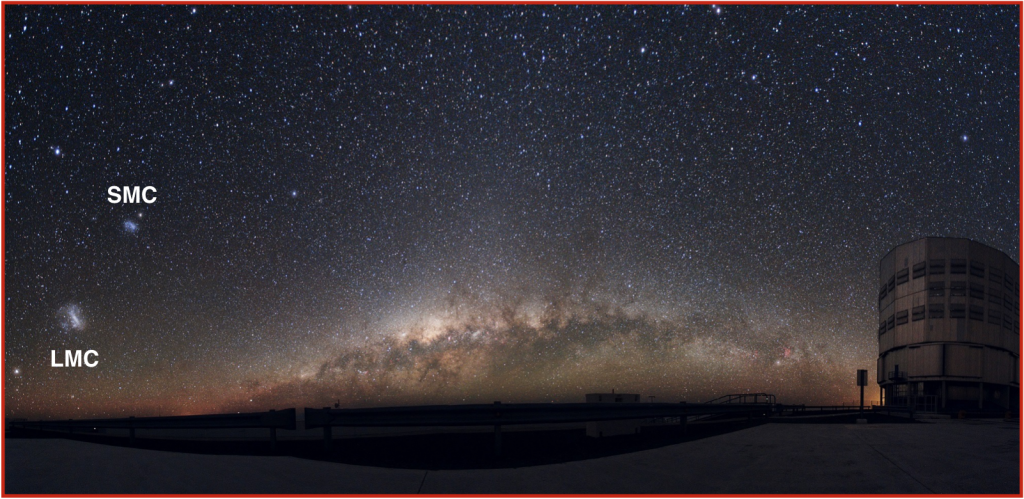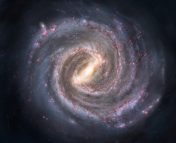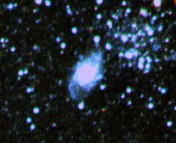Title: All-Sky Dynamical Response of the Galactic Halo to the Large Magellanic Cloud
Authors: C. Conroy, R. P. Naidu, N. Garavito-Camargo, G. Besla, D. Zaritsky, A. Bonaca, B. D. Johnson
First Author’s Institution: Center for Astrophysics | Harvard and Smithsonian, Cambridge, MA, USA
Status: Published in Nature [closed access]
In equilibrium or not in equilibrium; that is the question
That our own Milky Way is by far the best-studied Galaxy in the Universe should not come as a surprise – it is, after all, the Galaxy we inhabit, and the one in which telescopes are best able to observe stars, gas, and dust. Despite this, there remain a number of exciting open questions when it comes to studying the Milky Way and its local environment, including but not limited to:
How massive is the Milky Way?
What are the masses and orbital properties of the satellite galaxies in our neighbourhood?
How does the Milky Way influence the evolution of its satellites, and what impact do those satellites have on it in return?
In many sub-fields of astrophysics, measuring masses requires knowing something about the orbital dynamics of objects and their environments. The key idea here is that gravity is by far the dominant force in the Universe on large scales. Thus, our understanding of gravity allows us to infer the masses of individual stars, black holes, and even entire galaxies based on the gravitational influence they have on objects in their vicinity.
Most traditional methods of studying the Milky Way’s mass and the orbits of its satellites assume that the Galaxy is in gravitational equilibrium. However, more recent studies have increasingly given credence to the idea that this might not be the case, and that the Milky Way is in fact quite perturbed due to the gravitational influence of its satellites. The authors of today’s paper provide new evidence to show that this is especially true for the outer reaches of our Galaxy – its stellar and dark matter halos.
A Large Magellanic Perturber
In particular, their study examines the gravitational impact of the Large Magellanic Cloud (LMC) on the Milky Way. The Magellanic Clouds are two of the most famous satellites of our Galaxy, and the LMC is the most massive one (other astrobites focusing on the Magellanic Clouds, include this and this). Given its mass, it is reasonable to presume that of all the satellite galaxies of the Milky Way, the LMC dominates when it comes to influencing Milky Way dynamics. Through their work, today’s authors provide conclusive observational evidence for the response of the Milky Way’s stellar halo to the LMC’s gravitational influence!

To properly study the dynamical response of the Milky Way’s stellar halo to the LMC’s presence, the authors needed a large sample of stars throughout the stellar halo. To achieve this, they turned to Gaia for optical data and WISE for infrared. Armed with high-quality photometry from both missions, they ignored all stars located in the disk of the Milky Way as well as those within the Magellanic Clouds themselves – this allowed them to focus solely on the stellar halo and obtain a sample of ~1300 stars.
They used this sample to search for over- and under-densities in different parts of the halo. In the absence of any gravitational perturbations, one would expect the distribution of halo stars to be uniform, i.e., one would expect the stellar halo to be in equilibrium. Variations in the stellar density field would indicate that the Milky Way is not in gravitational equilibrium, and the nature of the variations would depend on the mass and orbital properties of the perturber (in this case, assumed to be the LMC)!

Figure 2 shows their main result: in an-all sky map of their observed dataset in the left-hand panel, one can easily make out both stellar overdensities (in red) identified in their study – one in the southern hemisphere, termed the “Local Wake”, and another, more global one in the northern hemisphere called the “Collective Response”. The southern Local Wake trails the orbit of the LMC and is thought to be the effect of dynamical friction – essentially a bunching up of stars due to the gravitational pull of a perturber (the LMC) as it ploughs through them, somewhat analogous to the wake left behind by a boat moving through water at high speed. The northern Collective Response is a result of the net movement of the Galactic barycentre (roughly centre of mass) in response to the orbit of the LMC.
The right-hand panel in Figure 2 shows the expected locations and strengths of stellar overdensities in an N-body simulation that they use to compare to the observed data. Although there are certain differences in the strengths and symmetries of each effect, the simulation predicts both the southern Local Wake and the northern Collective Response, adding support to the reasoning behind the physics of both phenomena!

Figure 3 shows their comparison of the strengths of the southern and northern phenomena in the observed data and four different runs of their simulations. Here the “strengths” of each effect are represented in terms of the overdensity relative to the overall background field of stars. In particular, they show that both the Local Wake and Collective Response are stronger in the data compared to the simulations; the former to a larger degree. Given how many parameters are at play (masses of the Milky Way and the LMC, the exact orbital path of the LMC, and the overall shape of the Milky Way’s stellar halo, to name a few), it is not surprising that the simulations don’t perfectly agree with the dataset. However, the fact that both the effects are so prominent regardless of whether one looks at the data or at simulations, is in itself a strong result!
Implications for Galactic Dynamics
The surprising strength of the Local Wake trailing the LMC implies that the Magellanic Clouds are on their first ever infall into the Milky Way’s gravitational potential (if they had been on their second or higher infalls, the wake would have been much weaker because of the cumulative impact of tidal forces). Additionally, these accurate measurements of both responses also provide important constraints on the masses of the Milky Way and LMC, as well as the orbital path of the Magellanic Clouds. Just as importantly, future studies could test alternative models of dark matter by relying on the nature and strength of the Local Wake – since dark matter is about 90% of the mass of the Milky Way and plays a fundamental role in the dynamics of our Galaxy, its nature would most certainly have an impact on the characteristics of the Wake. By providing strong evidence for the Milky Way being in disequilibrium, today’s paper lays down an important foundation for all future work on the dynamics of our own Galaxy as well as its local neighbourhood.
Astrobite edited by Jamie Sullivan
Featured image credit: European Southern Observatory (ESO)




